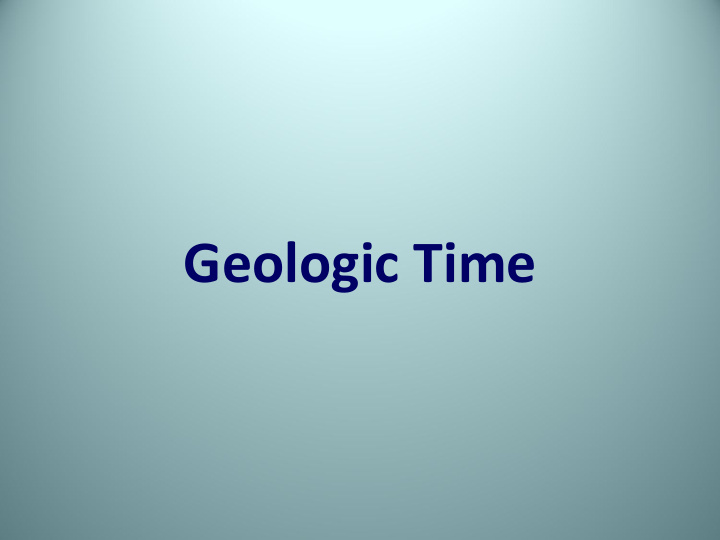



Geologic Time
Geologic Time Scale • Divisions of Earth’s history based on life forms that were living during certain periods
• Separation = Change. • Correlate geologic events, environmental changes, and changes among life forms
The Geologic Time Scale • Record of Earth’s history • Names of the time periods don’t change but their boundaries are always being changed.
Scale is cut into different sections: 1) Eon – longest time unit on the scale Hadean (oldest) Archean Proterozoic Phanerozoic (youngest)
2) Era – next longest span of time • Defined by the different life forms that are found in the rocks. Marked by major, striking, worldwide changes like mass extinction Precambrian (oldest) Paleozoic Mesozoic Cenozoic (youngest)
- Precambrian Era – microscopic life - Paleozoic Era – Age of Trilobites - Mesozoic Era – Age of Reptiles - Cenozoic Era – Age of Mammals
3) Periods – defined by the life forms that were abundant or became extinct during the time in which the rock was deposited. Third longest division of time.
4) Epochs – smaller division of geologic time.
Trilobites • Make excellent index fossils b/c their characteristics changed every period • Paleontologists uses changes to determine the environment
Movement of Pangea • Closed seas • Formed mountains • Not a completely acceptable explanation for extinctions
Precambrian Time • 4.5 billion yrs – 544 million yrs • Longest part of Earth’s history • Little known about org. in this time period b/c: – 4 million yr old rock buried deeply and experiences enough heat & pressure to destroy fossils – Most org. had soft parts
Precambrian Time • How life changed: – Cyanobacteria – algae that photosynthesized producing O 2 – O 2 created ozone layer allowing the evolution of more complex organisms – Invertebrates – (no backbone) appeared towards end of Precambrian Time • Ex: jellyfish, worms
Precambrian Time • End: – Extinctions – New org. out-competed old org. – Scientists not completely sure
Paleozoic Era – Era of Ancient Life • 544 million yrs – 248 million yrs • How life changed: – mostly marine org. so large seas – Trilobites and shelled org. common so abundance of fossils
Paleozoic Era – Vertebrates (backbone) evolved – Forest appeared – gymnosperms – plants producing seeds only – Vertebrates began to adapt to land = amphibians ex. Frog • Purpose was org. needed to survive in oxygen poor waters • Can’t keep moisture in their bodies and need water to lay their eggs
Paleozoic Era – Several mtn. building episodes – Appalachian Mountains formed • End: – 90% of marine, 70% land species died – Volcanoes? – Asteroid/comet collision?
Mesozoic Era – Middle Life • 248 million yrs – 65 million yrs • How life changed: – Pangea seperated into 2 landmasses Laurasia, Gondwanaland – Reptiles – Dinosaurs
Mesozoic Era – Birds appeared during Jurassic Period – Mammals appeared during Triassic Period – Angiosperms – flowering plants – started evolving during Cretaceous Period
Mesozoic Era • End: – Mass extinction – Comet/asteroid collision causing dust/smoke to block out sun – Some survivors
Cenozoic Era – Recent Life • 65 million yrs – present • How life changed: – Mountain building episode: Alps, Andes, Himalayas – Grassland expansion – grazing mammals become larger
Cenozoic Era – Continents split further, org. became isolated and began to evolve • Marsupials – koala, wombat, kangeroos – HUMANS
Recommend
More recommend